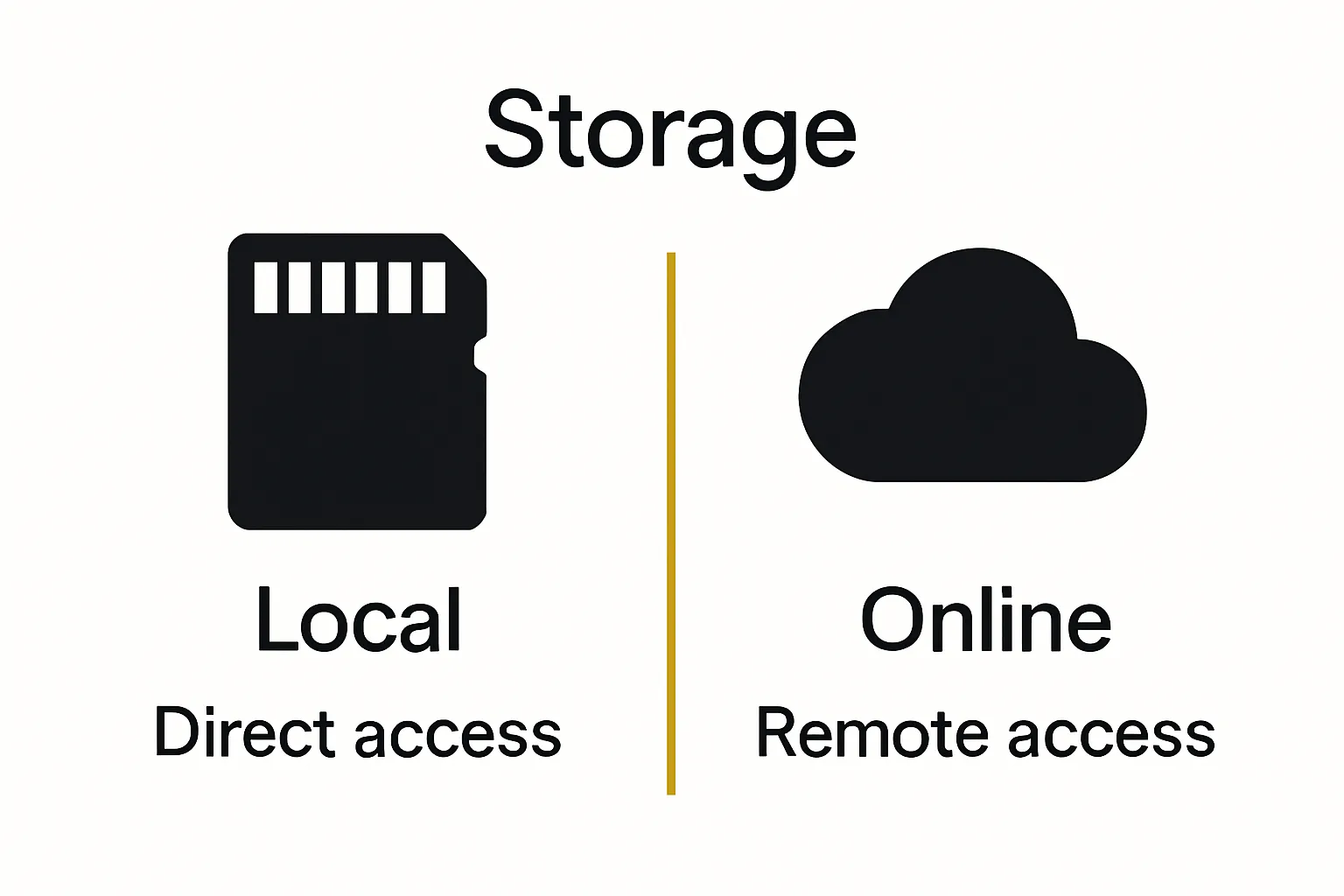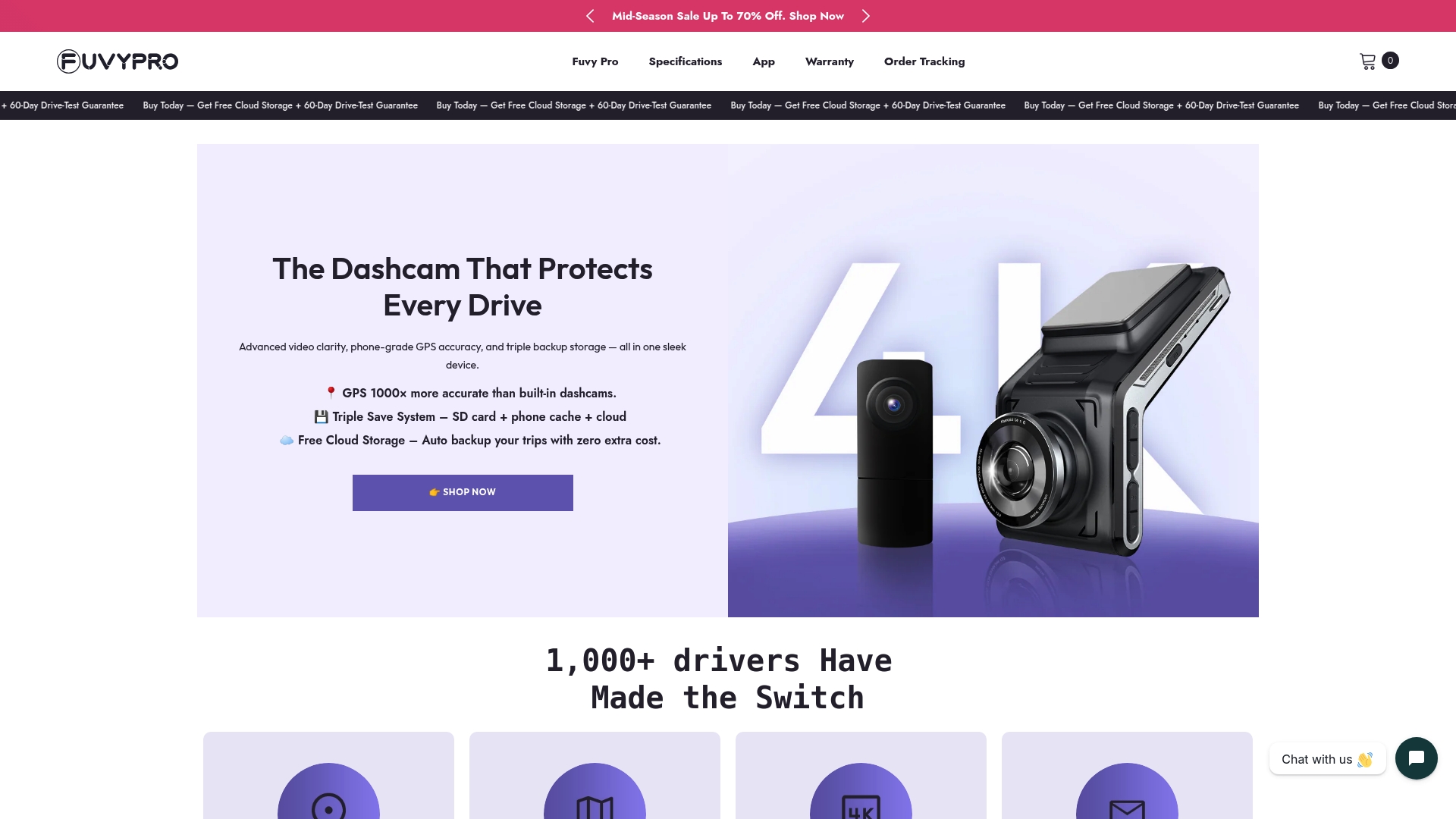Understanding Dashcam Storage Comparison Guide Clearly
Understanding Dashcam Storage Comparison Guide Clearly

Every driver wants proof when something unexpected happens on the road and dashcams seem like the obvious answer. Here is the wild part. A dashcam with low-quality storage can actually miss or corrupt the most important footage right when you need it most. Most people assume any memory card will do but there is a surprising science behind how storage makes or breaks your whole dashcam experience.
Table of Contents
- What Is Dashcam Storage And Why Is It Important?
- Types Of Dashcam Storage: Memory Cards Vs. Cloud Storage
- How Dashcam Storage Affects Recording Quality And Safety
- Key Considerations For Choosing The Right Storage For Your Dashcam
Quick Summary
| Takeaway | Explanation |
|---|---|
| Choose reliable storage types | Opt for either high-capacity memory cards or cloud storage for safety and accessibility. |
| Prioritize speed for quality | Higher write speeds ensure clear, uninterrupted video recordings, especially at high resolutions. |
| Understand capacity needs | Select storage based on your driving frequency; larger capacities suit frequent users better. |
| Consider automatic backup options | Implement cloud storage or backup features to protect against data loss or corruption. |
| Evaluate performance ratings | Look for Class 10 or UHS-I rated cards to guarantee effective continuous recording. |
What is Dashcam Storage and Why is it Important?
Dashcam storage represents the digital memory system that captures, saves, and preserves video recordings of your driving experiences. When you drive, your dashcam continuously records footage onto specialized storage media, creating a reliable visual record of road events. Research from transportation safety experts indicates that proper storage mechanisms are crucial for maintaining accurate driving documentation.
The Core Purpose of Dashcam Storage
At its fundamental level, dashcam storage serves multiple critical functions beyond simple video recording. These storage systems protect drivers by providing verifiable evidence in case of accidents, insurance claims, or legal disputes. The storage technology ensures that critical moments are captured with precision and can be retrieved when needed.
Key Components of Dashcam Storage:
- Memory cards (SD/microSD)
- Internal hard drive storage
- Cloud storage solutions
- Automatic backup systems
Technical Mechanics of Storage
Modern dashcam storage operates through sophisticated digital recording technologies that continuously overwrite older footage while maintaining the most recent recordings. This means your device will always have space for new video files, automatically managing memory to prevent storage exhaustion. Explore our advanced recording system that integrates seamless storage management.
Drivers should understand that storage isn’t just about saving space—it’s about preserving critical moments that could potentially protect your legal interests, provide insurance evidence, or document unexpected road incidents. The right storage solution transforms your dashcam from a simple recording device into a comprehensive driving protection tool.
Types of Dashcam Storage: Memory Cards vs. Cloud Storage
Drivers today have multiple storage options for preserving their driving recordings, each with unique advantages and limitations. Understanding these different storage types helps you select the most appropriate solution for your specific needs. Consumer electronics research reveals significant variations in storage performance and reliability.
Physical Memory Cards: Local Storage Powerhouse
Memory cards represent the traditional and most direct method of dashcam storage. These compact digital storage devices typically include microSD cards that plug directly into your dashcam. Key characteristics of memory cards include:
- Immediate local access to recordings
- Cost effective storage solution
- Quick transfer of files to other devices
- Varying storage capacities from 32GB to 512GB
Physical memory cards provide drivers with direct control over their footage. Users can quickly remove the card, insert it into a computer, and review recordings without internet connectivity.
Below is a comparison table organizing the characteristics, advantages, and limitations of physical memory cards versus cloud storage for dashcam systems.
| Storage Type | Key Advantages | Limitations | Ideal For |
|---|---|---|---|
| Memory Cards | Immediate local access, cost effective, quick file transfer, direct control over footage | Physical card damage, risk of loss, limited by size | Drivers wanting easy local access |
| Cloud Storage | Automatic backup, remote access, protection against physical loss, long-term preservation | Requires internet, possible ongoing costs, tech complexity | Those prioritizing security and remote access |

Cloud Storage: The Modern Digital Approach
Cloud storage offers a sophisticated alternative to traditional memory card systems.
By automatically uploading recordings to secure online servers, cloud solutions provide additional layers of protection and accessibility. Learn more about our advanced recording system that integrates seamless cloud management.
Advantages of Cloud Storage:
- Automatic backup of critical footage
- Remote access from multiple devices
- Protection against physical card damage or loss
- Potential for longer term video preservation
While cloud storage introduces more technological complexity, it significantly enhances the reliability and accessibility of your driving recordings. Modern dashcam systems increasingly integrate both local and cloud storage methods to provide comprehensive protection.
How Dashcam Storage Affects Recording Quality and Safety
Dashcam storage is not merely about saving video files—it directly impacts the reliability, clarity, and usefulness of your driving recordings. Digital video research demonstrates that storage technology fundamentally influences video capture quality and data preservation.
Storage Speed and Video Resolution
Storage performance critically determines video quality. Different storage media have varying write speeds that directly affect how smoothly and clearly your dashcam can record footage. Slower storage cards might result in dropped frames, reduced resolution, or fragmented video recordings. High-performance storage solutions ensure:
- Continuous, uninterrupted video capture
- Maintenance of high resolution (4K, 1080p)
- Rapid data writing without performance bottlenecks
- Minimal video compression artifacts
Drivers should prioritize storage solutions that can handle high-speed video recording without compromising visual clarity or smoothness.

Safety and Reliability of Storage Systems
The right storage system provides more than just video preservation—it offers a critical safety mechanism for documenting road events. Explore our comprehensive dashcam app that enhances storage reliability. Robust storage solutions protect against potential data loss through:
- Automatic emergency file locking
- Redundant backup mechanisms
- Rapid file transfer capabilities
- Protection against physical card corruption
Ultimately, your dashcam’s storage system is the guardian of your driving evidence. Choosing high-quality, reliable storage ensures that crucial moments are captured accurately and can be retrieved when most needed.
Key Considerations for Choosing the Right Storage for Your Dashcam
Selecting the optimal storage solution for your dashcam involves more than simply purchasing the largest memory card available. Drivers must carefully evaluate multiple technical and practical factors to ensure reliable, high-quality video recording. Storage technology experts recommend a comprehensive approach to storage selection.
Technical Performance Metrics
Dashcam storage performance depends on several critical technical specifications. Write speed and data transfer rates are paramount in determining how effectively your device can record continuous video. Different storage cards offer varying performance levels that directly impact recording quality:
- Video resolution compatibility
- Sustained write speed requirements
- Thermal and environmental durability
- Maximum read/write cycle capabilities
Drivers should prioritize cards with Class 10 or UHS-I ratings, which guarantee minimum performance standards for continuous video recording.
Capacity and Longevity Considerations
Storage capacity directly influences how much driving footage you can preserve. While larger capacity cards might seem attractive, drivers must balance storage size with card reliability and replacement cost. Explore our comprehensive dashcam solutions designed to maximize storage efficiency.
Recommended Storage Capacities:
- 64GB: Suitable for daily commuters
- 128GB: Ideal for frequent drivers
- 256GB: Recommended for rideshare and professional drivers
Ultimately, the right storage solution provides a delicate balance between performance, capacity, and long-term reliability. Drivers should view storage not as a one-time purchase, but as a critical component of their vehicle safety ecosystem.
See the Difference With Smarter Dashcam Storage
Are you tired of losing footage right when you need it most, frustrated by unreliable memory cards, or worried that your driving evidence might disappear? The article above made it clear how the right storage can protect you, but also revealed just how easy it is for traditional storage solutions to fall short. Outdated systems often lose critical clips or falter in emergencies, putting your proof and peace of mind at risk. With real-world stakes this high, you deserve a next-generation solution that covers every angle.
Get a firsthand look at reliable storage and total driving peace of mind on our Home page.

Choose Fuvymyt and experience the power of TripleShield Save. Every recording is instantly backed up to your SD card, phone, and cloud automatically. No more worrying about memory limits, missing files, or loss after an accident. Ready for effortless proof in every situation? Explore our Toyota Dashcams or discover models tailored for Honda drivers. Make your next drive the safest and most reliable ever — visit our main site and protect your journeys today.
Frequently Asked Questions
What types of storage are available for dashcams?
Dashcams typically offer two main types of storage: physical memory cards (such as microSD cards) and cloud storage solutions. Memory cards provide immediate local access to recordings, while cloud storage offers automatic backups and remote access.
How does dashcam storage affect video quality?
The performance of dashcam storage directly impacts video quality. Higher write speeds on storage media ensure smooth, uninterrupted recording and better resolution, while slower storage may lead to dropped frames or reduced video clarity.
What should I consider when choosing dashcam storage capacity?
When selecting storage capacity for your dashcam, consider your driving frequency and the amount of footage you want to keep. Recommended capacities range from 64GB for daily commuters to 256GB for rideshare and professional drivers to ensure sufficient recording time.
The following table summarizes the recommended dashcam storage capacities based on driving frequency and intended use, as discussed in the article.
| Storage Capacity | Recommended For | Typical Usage Scenario |
|---|---|---|
| 64GB | Daily commuters | Regular daily driving |
| 128GB | Frequent drivers | Extended or multiple daily trips |
| 256GB | Rideshare/professionals | Long hours or professional driving |
How can I ensure the reliability of my dashcam’s storage system?
To enhance the reliability of your dashcam’s storage, select high-quality memory cards with at least Class 10 or UHS-I ratings, utilize automatic emergency file locking features, and consider a storage system that integrates both local and cloud solutions.

